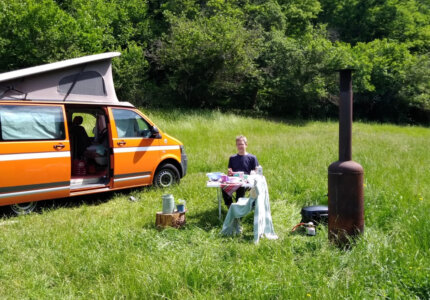
What belongs to a sustainable website
There is a lot that goes into a sustainable website: green electricity, smaller images, inclusion and accessibility, good loading speeds and much more.
One aspect that may often not be connected at first glance is data protection. Apart from social sustainability, the protection of our privacy, tracking consumes a lot of power.
In his book “The battle for the Internet” (“Der Kampf um das Internet”), Stephan Mey quotes a study from 2018 which states that approximately 50% of data traffic is caused by tracking and advertising. To illustrate once more: The internet is responsible for 830 million tons of CO2, more than the worldwide air traffic. Real privacy protection could save a lot of energy here.
Less Cookies = less data = less energy
If website owners asked themselves, how much really needs to be tracked and advertised and if there are no more sustainable marketing options, they could reduce energy consumption and increase privacy protection at the same time.
What exactly can that look like?
I have put together some steps for you here, that you can implement yourself on your website.
Alternatives to Google Analytics
If you want to know, how many people find your website and which pages they stay on, you don’t need Google Analytics. There are various considerably more privacy-friendly and data-minimising alternatives. Probably the most frequently mentioned would be Matomo.
Let’s be honest, how many of the vast selection of the metrics available in Analytics do you really look at? Especially for smaller businesses it suffices, in my opinion, to know the rough key figures that you can collect using a simple plugin.
Find sustainable Advertising Partners
Amazon is popular as an advertising partner. But not sustainable, unfortunately. There are various other partnerships here too, that you can enter to earn something extra. For example, AvocadoStore and Buch Sieben have their own affiliate programmes. Here you can find another post about this topic.
Use Open Source
Anywhere you can view the source code, you can (at least with technical knowledge) also see where your data is going to. You can contribute to the community-based software development or express your wishes. Unlike large corporations, where the person at the top does not oversee the well-being of everyone but the highest profit.
Don’t use Dark Patterns
With the help of dark or deceptive patterns (manipulative design elements that make users do things they don’t want to do), a huge amount of data is being collected, and a multitude of products are sold, which perhaps would never have had to be produced without it.
A very popular dark pattern is “misdirection”, using color, size, or position to strongly emphasize certain options and hide others. The cookie banner is a particularly popular object. Most of all sites don’t use an equivalent representation to accept or reject cookies. The WordPress plugin that I use for my cookie banner even defaults to two different colors (grey-white for “reject” but beautifully and colorfully highlighted for “accept”).
Sure, these banners are annoying (and, in my opinion, they don’t contribute to privacy protection), many just click them away by clicking on the button highlighted in color instead of looking for the hidden “reject” option. And data started flowing again, to be stored on a server that consumes lots of electricity.
Collaborate with Sustainable Web Designers and Web Developers
If you don’t create or maintain your website yourself, you can also look for sustainable partners who are familiar with sustainability and privacy protection. Ingo is of course a good choice here. I also offer sustainable graphic and web design 🙂
Choose which Websites you visit
Last, but not least, you, as a website visitor, can be picky: it’s in your own hand, where you read articles, where you shop online, and who you would like to share your data with via the cookie banner.
Inspired greetings,
Michelle from Buchfink Design





